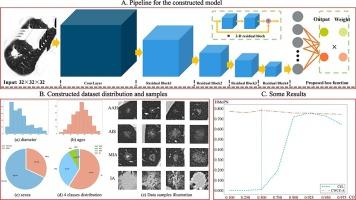基于深度神经网络的肺肿瘤侵袭性自动预测
IF 2.3
4区 医学
Q3 ENGINEERING, BIOMEDICAL
引用次数: 0
摘要
早期肺癌的侵袭性检测对于进一步治疗和挽救生命非常重要。在临床实践中,肺肿瘤的侵袭性(LTI)检测非常具有挑战性,基于成像的自动预测算法提供了一种非侵入性的方法。然而,缺乏公开可用的数据集和临床分类的不平衡是限制自动预测方法发展的关键问题。为了解决上述问题,我们从804例患者中收集了大量标记良好的高质量计算机断层扫描数据集,并根据术后金标准病理报告对每个样本进行二元分类标记。然后,提出了一种新的人工系统——肺肿瘤侵袭性预测神经网络(LTI-Net),通过解决类不平衡问题,提高在这种不平衡设置下的性能诊断,对肺肿瘤进行二值分类。我们采用三维残差神经网络作为主干架构,通过扫描成像数据中病变区域CT值的分布变化,有效捕获肿瘤内异质性。此外,我们引入了一个新的替代函数来近似曲线下面积(AUC)度量。通过在训练过程中利用正负样本对,该公式在保持稳定的优化动态的同时增强了判别特征提取。在我们收集的数据集上进行的综合实验证明了我们的LTI-Net方法的潜力。与现有的最先进的方法相比,LTI-Net显著提高了真阳性率和真阴性率(hmpn)调和平均值的得分,在不同的不平衡设置下提高了2.92%的hmpn得分。本文章由计算机程序翻译,如有差异,请以英文原文为准。

Automatically predicting lung tumor invasiveness using deep neural networks
Early lung cancer invasive detection is important for further treatment and saving lives. In clinical practice, lung tumor invasiveness (LTI) detection is very challenging, imaging-based automatic prediction algorithms offer a non-invasive approach. However, the lack of publicly available datasets and the imbalance of clinical categories are key issues limiting the development of automatic predictive methods. To address the above issues, a large well-labeled high-quality computed tomography dataset was collected from 804 patients, and each sample was labeled with a binary classification label according to the gold standard pathological report after surgery. Then, a novel artificial system, lung tumor invasiveness prediction neural network (LTI-Net), was proposed to perform the binary classification of lung tumors by solving the class imbalance problem and improving the performance diagnosis under such imbalance settings. We adopted a three-dimensional residual neural network as the backbone architecture to effectively captures intra-tumor heterogeneity through scanning the distribution changes of CT values in lesion regions in imaging data. Additionally, we introduced a novel surrogate function to approximate the area under the curve (AUC) metric. By leveraging both positive and negative sample pairs during the training process, this formulation enhances discriminative feature extraction while maintaining stable optimization dynamics. Comprehensive experiments on our collected dataset demonstrated the potential of our LTI-Net method. LTI-Net improved the score of the harmonic mean of true positives rate and true negatives rate (HMoPN) significantly when compared to the current state-of-the-art methods and improved 2.92% of the HMoPN score in different imbalanced settings.
求助全文
通过发布文献求助,成功后即可免费获取论文全文。
去求助
来源期刊

Medical Engineering & Physics
工程技术-工程:生物医学
CiteScore
4.30
自引率
4.50%
发文量
172
审稿时长
3.0 months
期刊介绍:
Medical Engineering & Physics provides a forum for the publication of the latest developments in biomedical engineering, and reflects the essential multidisciplinary nature of the subject. The journal publishes in-depth critical reviews, scientific papers and technical notes. Our focus encompasses the application of the basic principles of physics and engineering to the development of medical devices and technology, with the ultimate aim of producing improvements in the quality of health care.Topics covered include biomechanics, biomaterials, mechanobiology, rehabilitation engineering, biomedical signal processing and medical device development. Medical Engineering & Physics aims to keep both engineers and clinicians abreast of the latest applications of technology to health care.
 求助内容:
求助内容: 应助结果提醒方式:
应助结果提醒方式:


